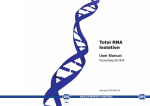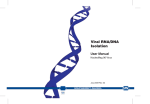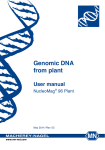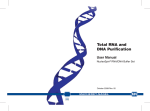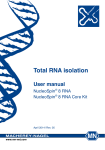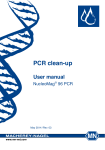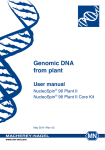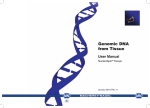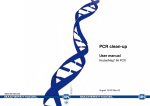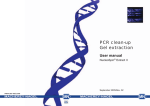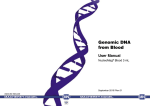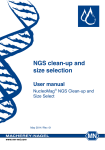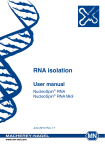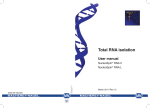Download Total RNA Isolation - Lab Supplies Scientific
Transcript
Total RNA Isolation User Manual NucleoMag 96 RNA March 2009/ Rev. 01 MACHEREY-NAGEL MN Total RNA Isolation Table of contents 1 2 Components 4 1.1 Kit contents 4 1.2 Material to be supplied by user 5 Product description 6 2.1 The basic principle 6 2.2 Kit specifications 6 2.3 Magnetic separation systems 7 2.4 Adjusting the shaker settings 8 2.5 Handling of beads 8 2.6 Elution procedures 9 3 Storage conditions and preparation of working solutions 10 4 Safety instructions – risk and safety phrases 11 5 Procedure 13 5.1 General procedure 13 5.2 Protocol for the isolation of total RNA from cells or tissue 15 Appendix 18 6.1 Troubleshooting 18 6.2 Ordering information 20 6.3 Product use restriction / warranty 21 6 MACHEREY-NAGEL – 03 / 2009, Rev. 01 3 Total RNA Isolation 1 Components 1.1 Kit contents NucleoMag 96 RNA 1x 96 preps 4 x 96 preps 744350.1 744350.4 NucleoMag B-Beads 3 ml 12 ml Lysis Buffer MR1 50 ml 200 ml Binding Buffer MR2 80 ml 320 ml Wash Buffer MR3 80 ml 360 ml Wash Buffer MR4 250 ml 1000 ml Elution Buffer MR5 25 ml 100 ml 1 vial (107 mg / vial) 4 vials (107 mg / vial) 3 vials (size D) 12 vials (size D) Reaction Buffer for rDNase 35 ml 4 x 35 ml RNase-free H2O 5 ml 20 ml 1 1 Cat. No. Reducing Agent TCEP rDNase, lyophilized User Manual * For preparation of working solutions and storage conditions see section 3. 4 MACHEREY-NAGEL – 03 / 2009, Rev. 01 Total RNA Isolation 1.2 Material to be supplied by user Product Cat. No. Separation plate for magnetic beads separation, e.g. Square-well Block (96-well block with 2.1 ml square-wells) 740481 740481.24 4 24 Lysis tubes for incubation of samples and lysis, e.g. Rack of Tubes Strips (1 set consists of 1 Rack, 12 Strips with 8 tubes (1.2 ml wells) each, and 12 Cap Strips) 740477.4 740477.24 4 sets 24 sets 740486.24 24 740673 20 740951 1 set Elution plate for collecting purified RNA, e.g. Elution Plate, U-bottom (96-well 0.3 ml microtiterplate with 300 µl u-bottom wells) e.g. Elution Plate, Flat-bottom (96-well 0.3 ml microtiterplate with 300 µl flat-bottom wells) For use of kit on KingFisher 96 instrument: KingFisher 96 Accessory Kit B (Square-well Blocks, Deep-well tip combs, Elution Plates for 4 x 96 NucleoMag 96 RNA preps using King Fisher 96 platform) MACHEREY-NAGEL – 03 / 2009, Rev. 01 Pack of 5 Total RNA Isolation 2 Product description 2.1 The basic principle The NucleoMag 96 RNA procedure is based on the reversible adsorption of nucleic acids to paramagnetic beads under appropriate buffer conditions. Sample lysis is achieved by homogenization in a solution containing chaotropic ions. For the adjustment of conditions under which nucleic acids bind to the paramagnetic beads Buffer MR2 and the NucleoMag B-Beads are added to the lysate. After magnetic separation the paramagnetic beads are incubated with a recombinant DNase to remove co-purified DNA. Following a RNA rebinding step contaminants and salts are removed using the Wash Buffers MR3 and MR4. Residual ethanol from previous wash steps is removed by air drying. Finally, highly pure RNA is eluted with low-salt Elution Buffer (MR5) and the RNA can directly be used for downstream applications. The NucleoMag 96 RNA kit can be used either manually or automated on standard liquid handling instruments or automated magnetic separators. 2.2 Kit specifications NucleoMag 96 RNA is designed for rapid manual and automated small-scale preparation of highly pure total RNA from tissue or cell samples. The kit is designed for use with NucleoMag SEP magnetic separator plate (see ordering information) or other magnetic separation systems (see section 2.3). Manual time for the preparation of 96 samples is about 120 minutes. The purified RNA can be used directly as template for RT-PCR, or any kind of enzymatic reactions. Due to the recombinant DNase provided with the kit, eluted RNA is virtually DNA-free. NucleoMag 96 RNA allows easy automation on common liquid handling instruments or automated magnetic separators, e.g., Thermo Scientific´s KingFisher instruments. The actual processing time depends on the configuration of the instrument and the magnetic separation system used. Typically, 96 samples can be purified in less than 120 minutes using the NucleoMag SEP on the automation platform. The kit provides reagents for the purification of up to 30 µg of pure RNA from suitable samples. Depending on the elution volume used concentrations of 10 - 30 ng / µl can be obtained. NucleoMag 96 RNA can be processed completely at room temperature. NucleoMag B-Beads are highly reactive superparamagnetic beads. The binding capacity is approx. 1 µg of RNA per 1 µl of NucleoMag-B-Bead Suspension, 1 µl of suspension contains 130 µg of beads. 6 MACHEREY-NAGEL – 03 / 2009, Rev. 01 Total RNA Isolation 2.3 Magnetic separation systems For use of NucleoMag 96 RNA the use of the magnetic separator NucleoMag SEP is recommended. Separation is carried out in a Square-well Block (see ordering information). The kit can also be used with other common separators. See suppliers ordering information for suitable separation plates. Magnetic separator Separation plate or tube NucleoMag SEP (MN Cat. No. 744900) Square-well Block (MN Cat. No. 740670) Tecan Te-MagS 1.5 ml tubes without lid (Sarstedt) Static magnetic pins Separators with static magnetic pins, e.g. NucleoMag SEP (for manual use and for use on liquid handling workstations): This type of separator is recommended in combination with a suitable microplate shaker for optimal resuspension of the beads during the washing and elution steps. Alternatively, beads can be resuspended in the buffer by pipetting up and down several times. For fully-automated use on liquid handling workstations a gripper tool is required, the plate is transferred to the magnetic separator for separation of the beads and transferred to the shaker module for resuspension of the beads. Movable magnetic systems Separators with moving magnetic pins, e.g. Te-MagS (for automated use only): Magnetic pins / rods are moved from one side of the well to the other and vice versa. Beads follow this movement and are thus pulled through the buffer during the wash and elution steps. Separation takes place when the system stops. Automated separators Separators with moving magnets, e.g., Thermo Scientific´s King Fisher instruments: Magnetic beads are transferred into suitable plates or tubes. Beads are resuspended from the rod-covered magnets. Following binding, washing or elution beads are collected again with the rod-covered magnets and transferred to the next plate or tube. MACHEREY-NAGEL – 03 / 2009, Rev. 01 7 Total RNA Isolation 2.4 Adjusting the shaker settings When using a plate shaker for the washing and elution steps the speed settings have to be adjusted carefully for each specific separation plate and shaker to prevent crosscontamination from well to well. Proceed as follows: Adjusting shaker speed for wash steps: • Load 900 µl dyed water to the wells of the separation plate. Place the plate on the shaker and start shaking with a moderate speed setting for 30 seconds. Turn off the shaker and check plate surface for small droplets of dyed water. • Increase speed setting, shake for an additional 30 seconds, and check plate surface for droplets again. • Continue increasing the speed setting until you observe droplets on top of the separation plate. Reduce speed setting, check again and use this setting for the washing step. Adjusting shaker speed for the elution step: • 2.5 Load 100 µl dyed water to the wells of the collection plate and proceed as described above. Handling of beads Distribution of beads A homogeneous distribution of the magnetic beads to the individual wells of the separation plate is essential for a high well-to-well consistency. Therefore, before distributing the beads make sure that the beads are completely resuspended. Shake the storage bottle well or place it on a vortexer shortly. Premixing magnetic beads with the binding buffer allows easier homogenous distribution of the beads to the individual wells of the separation plate. During automation, a premix step before aspirating the beads / binding buffer mixture from the reservoir is recommended to keep the beads resuspended. Magnetic separation time Attraction of the magnetic beads to the magnetic pins depends on the magnetic strength of the magnetic pins, the selected separation plate, distance of the separation plate from the magnetic pins, and the volume to be processed. The individual times for complete attraction of the beads to the magnetic pins should be checked and adjusted on each system. It is recommended to use the separation plates or tubes specified by the supplier of the magnetic separator. Washing the beads Washing the beads can be achieved by shaking or mixing. In contrast to mixing by pipetting up and down mixing by shaker or magnetic mixing allows simultaneous mixing of all samples. This reduces the time and number of tips needed for the preparation. Resuspension by pipetting up and down, however, is more efficient than mixing by a shaker or magnetic mix. 8 MACHEREY-NAGEL – 03 / 2009, Rev. 01 Total RNA Isolation Method Resuspension efficiency Speed Number of tips needed Magnetic mix + ++ Low Shaker ++ ++ Low Pipetting +++ +* High * 8-channel pipetting device 2.6 Elution procedures Purified total RNA can be eluted directly with the supplied Elution Buffer MR5. Elution can be carried out in a volume of ≥ 50 µl. It is essential to cover the NucleoMag B-Beads completely with elution buffer during the elution step. The volume of dispensed elution buffer depends on the magnetic separation system (e.g. the position of the pellet inside the separation plate). For efficient elution the magnetic bead pellet should be resuspended completely in the elution buffer. For some separators high elution volumes might be necessary to cover the whole pellet. MACHEREY-NAGEL – 03 / 2009, Rev. 01 9 Total RNA Isolation 3 Storage conditions and preparation of working solutions Attention: Buffers MR1 and MR3 contain chaotropic salt! Wear gloves and goggles! • All components of the NucleoMag 96 RNA kit should be stored at room temperature (20 - 25 °C) and are stable for up to one year. • All buffers are delivered ready-to-use. Before starting NucleoMag 96 RNA protocol prepare the following: • rDNase working solution: Add 800 µl of RNase-free H2O to each rDNase vial and incubate for 1 min at room temperature. Gently swirl the vials to completely dissolve the DNase. Be careful not to mix rDNase vigorously as rDNase is sensitive to mechanical agitation. If not used completely this working solution can be stored at - 20 °C for up to 6 month. Do not freeze / thaw the rDNase working solution more than three times. • rDNase reaction mixture: Add 9.2 ml Reaction Buffer for rDNase to 800 µl rDNase working solution and mix. The resulting rDNase reaction mixture will be sufficient for 32 isolations and should be used up. When performing less than 32 reactions prepare a smaller amount of the reaction mixture. For each isolation combine 276 µl of reaction buffer for rDNase with 24 µl of rDNase working solution. • Reducing Agent TCEP: Add 750 µl of RNase-free H2O to the TCEP vial and incubate for several minutes at room temperature. Mix the vial to dissolve the TCEP completely. Store dissolved TCEP at -20°C. NucleoMag 96 RNA Cat. No. rDNase (lyophilized) TCEP 10 1 x 96 preps 4 x 96 preps 24 x 96 preps 744350.1 744350.4 744350.24 3 vials (size D) 12 vials (size D) 24 vials (size D) Add 800 µl RNasefree H2O to each vial Add 800 µl RNasefree H2O to each vial Add 800 µl RNasefree H2O to each vial 1 vial (107 mg) 4 vials (107 mg / vial) 24 vials (107 mg / vial) Add 750 µl RNasefree H2O Add 750 µl RNasefree H2O to each vial Add 750 µl RNasefree H2O to each vial MACHEREY-NAGEL – 03 / 2009, Rev. 01 Total RNA Isolation 4 Safety instructions – risk and safety phrases The following components of the NucleoMag 96 RNA kits contain hazardous contents. Wear gloves and goggles and follow the safety instructions given in this section. Component Hazard contents Hazard symbol MR1 Guanidine thiocyanate Xn* MR2 Isopropanol > 90 % F Xi** MR3 Risk phrases Safety phrases Harmful by inhalation, in contact with the skin, and if swallowed R 20/21/22 S 13 Highly flammable - Irritating to eyes - Vapours may cause drowsiness and dizziness R 11-3667 S 7-1624/25-26 R 1020/21/22 S 7-13-16 Guanidine thiocyanate + ethanol < 40 % F Xn* Flammable - Harmful by inhalation, in contact with the skin, and if swallowed MR4 Ethanol < 80 % F** Highly flammable R11 S 7-16 rDNase, RNase-free rDNase, lyophilized Xi* May cause sensitization by inhalation and skin contact R 42/43 S 22-24 Reducing Agent TCEP Tris (2-carboxylethylphosphine Hydrochloride) Xi* Causes burns R 34 S 26-2736/37/39 Risk phrases R 10 Flammable R 11 Highly flammable R 20/21/22 Harmful if swallowed R 34 Causes burns R 36 Irritating to eyes R 42/43 May cause sensitization by inhalation and skin contact R 67 Vapours may cause drowsiness and dizziness * Hazard labeling not necessary if quantity per bottle below 125 g or ml (certificate of exemption according to 67/548/EEC Art. 25, 1999/45/EC Art. 12 and German GefStoffV § 20 (3) and TRGS 200 7.1). For further information see Material Safety Data Sheet. ** Hazard labeling not necessary if quantity per bottle below 25 g or ml (certificate of exemption according to 67/548/EEC Art. 25, 1999/45/EC Art. 12 and German GefStoffV § 20 (3) and TRGS 200 7.1). For further information see Material Safety Data Sheet. MACHEREY-NAGEL – 03 / 2009, Rev. 01 11 Total RNA Isolation Safety phrases S7 Keep container tightly closed S 13 Keep away from food, drink, and animal feedstuffs S 16 Keep away from sources of ignition - No smoking! S 22 Do not breathe dust S 24 Avoid contact with the skin S 24/25 Avoid contact with skin and eyes S 26 In case of contact with eyes, rinse immediately with plenty of water and seek medical advice S 27 Take off immediately all contaminated clothing S 36/37/38 Wear suitable protective clothing and gloves 12 MACHEREY-NAGEL – 03 / 2009, Rev. 01 NucleoMag 96 RNA 5 Procedure 5.1 General procedure 1 Homogenize / lyse sample Up to 20 mg tissue or 2 x 106 cells 350 µl MR1 6 µl TCEP Mix or use mechanical disruption 2 Bind RNA to NucleoMag B-Beads 350 µl MR2 28 µl B-Beads Mix Incubate 5 min at RT (Optional: Mix by shaking) Remove supernatant after 2 min separation Dry for 5 min at RT 3 rDNase digestion 300 µl rDNase reaction mixture Mix Incubate 15 min at RT 4 Rebinding 350 µl MR2 Incubate 5 min at RT Remove supernatant after 2 min separation MACHEREY-NAGEL – 03 / 2009, Rev. 01 13 NucleoMag 96 RNA 5 MR3 wash 600 µl MR3 Resuspend, separate, 2 min Aspirate and discard supernatant 6 MR4 wash 900 µl MR4 Resuspend, separate, 2 min Aspirate and discard supernatant Repeat washing step once 7 Drying Incubate for 10 min at RT 8 Elution 50 - 200 µl MR5 Shake 5 - 10 min, RT (Optional: Mix by pipetting up and down) Transfer eluted DNA after 2 min separation 14 MACHEREY-NAGEL – 03 / 2009, Rev. 01 NucleoMag 96 RNA 5.2 Protocol for the isolation of total RNA from cells or tissue This protocol is designed for magnetic separators with static pins (e.g. NucleoMag SEP) and suitable plate shakers. It is recommended using a Square-well Block for separation (see ordering information). Alternatively isolation of RNA can be performed in reaction tubes with suitable magnetic separators. This protocol is for manual use and serves as a guideline for adapting the kit to robotic instruments. 1 Homogenize / lyse sample Lyse up to 20 mg of tissue or 2 x 106 cells in 350 µl Buffer MR1. For tissue samples: Use a suitable homogenization tool to homogenize samples in Buffer MR1. Samples can be disrupted using bead based homogenization tools e.g., GenoGrinder* or Mixer Mill MM400* (see instrument manufacturers recommendations for suitable plates or tubes for homogenization) or any other suitable homogenization tools. Centrifuge the crude homogenate to pellet debris or remaining tissue particles. Alternatively NucleoSpin® RNA Filter Tubes or Plates can be used to clear the crude lysate (see ordering information). Transfer the clear supernatant to the Square-well Block (see ordering information) for further processing. For cells: Add Buffer MR1 to cell pellet. Pipette up and down several times to lyse the cells. Optionally: Use NucleoSpin® RNA Filter Tubes or Plates (see ordering information) or a syringe to reduce the viscosity of the lysate. Transfer lysate to the Square-well Block for further processing. 2 Bind RNA to NucleoMag B-Beads Add 28 µl resuspended NucleoMag B-Beads and 350 µl Buffer MR2 to the lysed sample. Mix by pipetting up and down 6 times and incubate for 5 min at room temperature. NucleoMag B-Beads and Buffer MR2 can be premixed. Be sure to resuspend the NucleoMag B-Beads before removing them from the storage bottle. Vortex storage bottle briefly until a homogenous suspension has formed. Separate the magnetic beads against the side of the wells by placing the Squarewell Block on the NucleoMag SEP magnetic separator. Wait at least 2 min until all the beads have been attracted to the magnets. Remove and discard supernatant by pipetting. Remove supernatant completely. Do not disturb the attracted beads while aspirating the supernatant. * GenoGrinder: http://www spexcsp.com/sampleprep/ Mixer Mill MM400 http://www.retsch.com/products/milling/ball-mills/mm-400/ MACHEREY-NAGEL – 03 / 2009, Rev. 01 15 NucleoMag 96 RNA Dry beads for 5 min at room temperature. Keep the Square-well Block on the NucleoMag SEP magnetic separator for the drying step. 3 rDNase digestion Remove the Square-well Block from the NucleoMag SEP magnetic separator. Add 300 µl rDNase reaction mixture and resuspend the beads by pipetting up and down. Incubate for 15 min at room temperature. Do not separate the beads! Following incubation proceed with step 4. 4 Rebinding Add 350 µl Buffer MR2 to each sample. Mix by pipetting up and down 6 times and incubate for 5 min at room temperature. Separate the magnetic beads against the side of the wells by placing the Square-well Block on NucleoMag Sep magnetic separator. Wait at least 2 min until all the beads have been attracted to the magnets. Remove and discard supernatant by pipetting. 5 MR3 wash Remove the Square-well Block from the NucleoMag SEP magnetic separator. Add 600 µl Buffer MR3 resuspend the beads by pipetting up and down. Incubate for 1 min. Separate the magnetic beads by placing the Square-well Block on the NucleoMag SEP magnetic separator. Wait at least 2 min until all the beads have been attracted to the magnets. Remove and discard supernatant by pipetting. 6 MR4 wash Remove the Square-well Block from the NucleoMag SEP magnetic separator. Add 900 µl Buffer MR4 and resuspend the beads by pipetting up and down. Incubate for 1 min. Separate the magnetic beads by placing the Square-well Block on the NucleoMag SEP magnetic separator. Wait at least 2 min until all the beads have been attracted to the magnets. Remove and discard supernatant by pipetting. Repeat washing step once with 900 µl Buffer MR4. Leave the Square-well Block on the NucleoMag SEP magnetic separator for the following step. 16 MACHEREY-NAGEL – 03 / 2009, Rev. 01 NucleoMag 96 RNA 7 Drying Air dry the beads for 10 - 15 min at room temperature. 8 Elution Remove the Square-well Block from the NucleoMag SEP magnetic separator. Add desired volume of Buffer MR5 (at least 50 µl, 50 - 200 µl) and resuspend the beads by pipetting up and down. Incubate the suspension for 5 min at room temperature. Separate the magnetic beads by placing the Square-well Block on the NucleoMag SEP magnetic separator. Wait at least 2 min until all the beads have been attracted to the magnets. Remove and discard supernatant by pipetting. Transfer the supernatant containing the purified total RNA to a suitable collection plate (see ordering information). MACHEREY-NAGEL – 03 / 2009, Rev. 01 17 Total RNA Isolation 6 Appendix 6.1 Troubleshooting Problem Possible cause and suggestions RNase contamination RNA is degraded / no RNA obtained • Create an RNase-free working environment. Wear gloves during all steps of the procedure. Change gloves frequently. Use of sterile, disposable polypropylene tubes or plates is recommended. Glassware should be oven-baked for at least 2 h at 250 °C before use. Elution buffer volume insufficient • Beads pellet must be covered completely with elution buffer. Insufficient performance of elution buffer during elution step. • Remove residual buffers during the separation steps completely. Remaining buffers decrease the efficiency of following wash and elution steps. Beads dried out Poor RNA yield • Do not let the beads dry as this might result in lower elution efficiencies. Aspiration of attracted bead pellet • Do not disturb the attracted beads while aspirating the supernatant, especially when the magnetic bead pellet is not visible in the lysate. Aspiration and loss of beads • Time for magnetic separation too short or aspiration speed too high. Insufficient washing procedure Low purity 18 • Use only the appropriate combinations of separator and plate, e.g. Square-well Block in combination with NucleoMag SEP. • Make sure that beads are resuspended completely during the washing procedure. If shaking is not sufficient to resuspend the beads completely mix by repeated pipetting up and down. MACHEREY-NAGEL – 03 / 2009, Rev. 01 Total RNA Isolation Poor performance of RNA in downstream applications Carry-over of ethanol from wash buffers • Be sure to remove all of the ethanolic wash solution, as residual ethanol interferes with downstream applications. Low purity • See above. Time for magnetic separation too short • Carry-over of beads Increase separation time to allow the beads to be completely attracted to the magnetic pins before aspirating any liquid from the well. Aspiration speed too high (elution step) • High aspiration speed during the elution step may cause bead carry over. Reduce aspiration speed for elution step. Contamination of the rims Cross contamination • Do not moisten the rims of the Square-well Block when transferring the tissue lysate. If the rim of the wells is contaminated, seal the Square-well Block with Self-adhering PE Foil (see ordering information) before starting the shaker. MACHEREY-NAGEL – 03 / 2009, Rev. 01 19 Total RNA Isolation 6.2 Ordering information Product Cat. No. NucleoMag 96 RNA 744350.1 744350.4 740350.24 NucleoSpin® Filters 740606 50 NucleoSpin® RNA Filter Plates 740711 4 NucleoMag SEP 744900 1 Square-well Blocks 740481.4 740481.24 4 24 Self-adhering PE Foil 740676 Rack of Tube Strips (set consists of 1 Rack, 12 Tube Strips with 8 tubes each and Cap Strips) 740477.4 740477.24 Pack of 1 x 96 preps 4 x 96 preps 24 x 96 preps 50 sheets 4 sets 24 sets Cap Strips 740638 30 strips KingFisher 96 Accessory Kit B Square-well Blocks, Deep-well tip combs, Elution Plates for 4 x 96 NucleoMag 96 RNA preps using King Fisher 96 platform 744951 1 set Visit www.mn-net.com for more detailed product information. 20 MACHEREY-NAGEL – 03 / 2009, Rev. 01 Total RNA Isolation 6.3 Product use restriction / warranty NucleoMag 96 RNA kit components were developed, designed, distributed, and sold FOR RESEARCH PURPOSES ONLY. They are suitable FOR IN - VITRO USES ONLY. No claim or representation is intended for its use to identify any specific organism or for clinical use (diagnostic, prognostic, therapeutic, or blood banking). It is rather the responsibility of the user to verify the use of the NucleoMag 96 RNA kit for a specific application range as the performance characteristic of this kit has not been verified to a specific organism. This MACHEREY-NAGEL product is shipped with documentation stating specifications and other technical information. MACHEREY-NAGEL warrants to meet the stated specifications. MACHEREY-NAGEL´s sole obligation and the customer´s sole remedy is limited to replacement of products free of charge in the event products fail to perform as warranted. Supplementary reference is made to the general business terms and conditions of MACHEREY-NAGEL, which are printed on the price list. Please contact us if you wish an extra copy. MACHEREY-NAGEL does not warrant against damages or defects arising in shipping and handling (transport insurance for customers excluded), or out of accident or improper or abnormal use of this product; against defects in products or components not manufactured by MACHEREY-NAGEL, or against damages resulting from such nonMACHEREY-NAGEL components or products. MACHEREY-NAGEL makes no other warranty of any kind whatsoever, and SPECIFICALLY DISCLAIMS AND EXCLUDES ALL OTHER WARRANTIES OF ANY KIND OR NATURE WHATSOEVER, DIRECTLY OR INDIRECTLY, EXPRESS OR IMPLIED, INCLUDING, WITHOUT LIMITATION, AS TO THE SUITABILITY, REPRODUCTIVITY, DURABILITY, FITNESS FOR A PARTICULAR PURPOSE OR USE, MERCHANTABILITY, CONDITION, OR ANY OTHER MATTER WITH RESPECT TO MACHEREY-NAGEL PRODUCTS. In no event shall MACHEREY-NAGEL be liable for claims for any other damages, whether direct, indirect, incidental, compensatory, foreseeable, consequential, or special (including but not limited to loss of use, revenue or profit), whether based upon warranty, contract, tort (including negligence) or strict liability arising in connection with the sale or the failure of MACHEREY-NAGEL products to perform in accordance with the stated specifications. This warranty is exclusive and MACHEREY-NAGEL makes no other warranty expressed or implied. The warranty provided herein and the data, specifications and descriptions of this MACHEREY-NAGEL product appearing in MACHEREY-NAGEL published catalogues and product literature are MACHEREY-NAGEL´s sole representations concerning the product and warranty. No other statements or representations, written or oral, by MACHEREY-NAGEL´s employees, agent or representatives, except written statements signed by a duly authorized officer of MACHEREY-NAGEL are authorized; they should not be relied upon by the customer and are not a part of the contract of sale or of this warranty. MACHEREY-NAGEL – 03 / 2009, Rev. 01 21 Total RNA Isolation Product claims are subject to change. Therefore please contact our Technical Service Team for the most up-to-date information on MACHEREY-NAGEL products. You may also contact your local distributor for general scientific information. Applications mentioned in MACHEREY-NAGEL literature are provided for informational purposes only. MACHEREY-NAGEL does not warrant that all applications have been tested in MACHEREY-NAGEL laboratories using MACHEREY-NAGEL products. MACHEREYNAGEL does not warrant the correctness of any of those applications. Please contact: MACHEREY-NAGEL Germany Tel.: +49 (0) 24 21 969 270 e-mail: [email protected] Last updated: 12 / 2006, Rev. 02 22 MACHEREY-NAGEL – 03 / 2009, Rev. 01





















